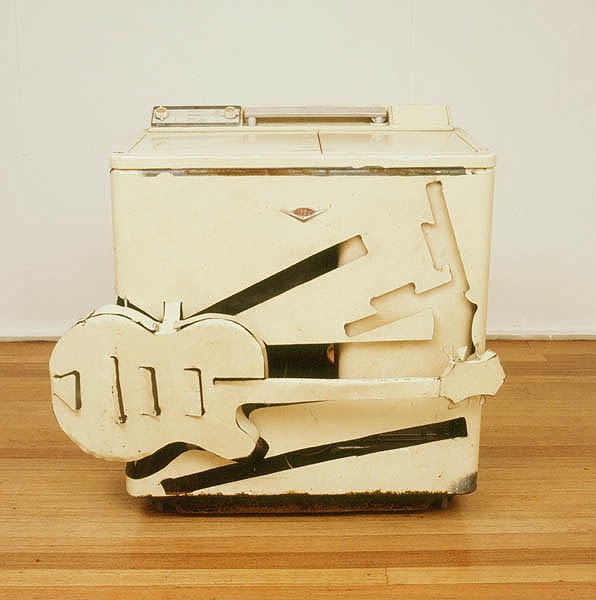Bill Woodrow
Twin-Tub with Guitar
1981
Bill Woodrow born 1948
Twin-Tub with Guitar
1981
Medium
Washing machine
889 x 762 x 660 mm
Tate
Acquisition
Purchased 1982
Bill Woodrow’s raw materials are familiar, domestic objects collected from the streets and junk yards in his neighbourhood. In
the early 1980s he began giving them new meanings by peeling back
their outer casing to form new objects. Here he has cut a sculpture of an electric guitar from a discarded Hotpoint washing machine.
This odd conjunction brings together two symbols of Western consumerism. Woodrow explained ‘The guitar was a pop icon and the washing machine was an everyday, domestic item. So it was bringing the two things together like a slice of life’.

English sculptor. In 1980 he first devised his characteristic method of making sculpture, forming a new object or objects from the skin of a found domestic appliance as in Twin-tub with Guitar (1981; London, Tate). Woodrow worked in such a way as to leave evident the original identities of the constituent items as well as the mode of transformation. His work is distinguished by its reliance on discarded consumer durables redolent of contemporary urban experience and by a witty and skilful manipulation of this raw material into a kind of three-dimensional drawing.

These juxtapositions of images and objects from ordinary life do not constitute didactic statements, but have an elliptical, poetic content. In later work Woodrow continued greatly to expand his raw material to encompass car doors and bonnets, industrial units and textiles, while also elaborating the symbolic and narrative implications of his constructions, for example Life on Earth (1984; Ottawa, N.G.), in which a group of vinyl chairs and a consumer durable are cunningly metamorphosed into an improvised theatre for a ‘home movie', where the fish on film seem to watch the human audience with as much curiosity as that of the spectator scrutinising the work of art. In the late 1980s, while retaining the symbolic and narrative elements characteristic of his earlier work, he began to work first in welded steel and then in cast bronze (e.g. Listening to History, 1995; artist's col., see 1996 exh. cat., p. 35).

English sculptor. In 1980 he first devised his characteristic method of making sculpture, forming a new object or objects from the skin of a found domestic appliance as in Twin-tub with Guitar (1981; London, Tate). Woodrow worked in such a way as to leave evident the original identities of the constituent items as well as the mode of transformation. His work is distinguished by its reliance on discarded consumer durables redolent of contemporary urban experience and by a witty and skilful manipulation of this raw material into a kind of three-dimensional drawing.

These juxtapositions of images and objects from ordinary life do not constitute didactic statements, but have an elliptical, poetic content. In later work Woodrow continued greatly to expand his raw material to encompass car doors and bonnets, industrial units and textiles, while also elaborating the symbolic and narrative implications of his constructions, for example Life on Earth (1984; Ottawa, N.G.), in which a group of vinyl chairs and a consumer durable are cunningly metamorphosed into an improvised theatre for a ‘home movie', where the fish on film seem to watch the human audience with as much curiosity as that of the spectator scrutinising the work of art. In the late 1980s, while retaining the symbolic and narrative elements characteristic of his earlier work, he began to work first in welded steel and then in cast bronze (e.g. Listening to History, 1995; artist's col., see 1996 exh. cat., p. 35).


